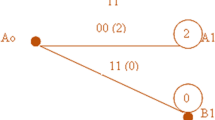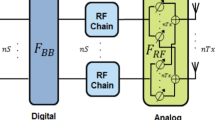Abstract
Real-time communication is affected by practical constraints such as node mobility and imperfect channel state information. Most technical contributions in the area of cooperative communication neglect these practical constraints, thus, assumes ideal propagation scenarios. Such approximations make sense in low-rate systems, but can lead to very false results when examining future high data rate systems. In this work, closed-form expression of pairwise error probability (PEP) is derived for dual hop and multiple hop selective decode-and-forward relaying network over time-selective Nakagami-m fading links. Space–time block code is used in combination with multiple-input multiple-output to achieve the diversity gain along with cooperative diversity. To obtain the optimal source-relay power allocation factors, a mathematical framework has been proposed to improve the performance of the system in the power-constraint situation. Simulation results have been presented for various values of fading severity parameter and channel variance. Results for different node-mobility scenarios are also provided. Results show that the system performance improves by increasing the fading severity parameter and relay-to-destination (RD) channel gain. It is noted that the relaying network’s diversity order (DO) is the same as the non-cooperative network’s DO in a scenario when both source node (SN) and destination nodes (DNs) are static, and relay node (RN) is mobile. Also, if the RN and DN are static and the SN is mobile, DO will be equivalent to zero. At high signal-to-noise ratio (SNR), system performance with equal and optimal energy distribution can be seen approaching an asymptotic floor limit, because system performance independent of the power of the noise components. The effect of mobility of the DN on the average per-block PEP output is less important compared to the mobility of the SN. The scheme is restricted by an asymptotic error floor with a greater SNR regime for other node-mobility situations. The analytical results are verified by Monte Carlo simulations for M-ary signaling maximal ratio combiner cooperative system.









Similar content being viewed by others
References
Vaezi, M., Ding, Z., Vincent Poor, H. (eds.) Multiple Access Techniques for 5G Wireless Networks and Beyond. Springer, Cham (2019)
Dragičević, T., Siano, P., Prabaharan, S.R.: Future generation 5G wireless networks for smart grid: a comprehensive review. Energies 12(11), 2140 (2019)
Vali Mohamad, N.M., Lakshmanan, M., Palanivelan, M., et al.: Development of an enhanced secured authentication and key agreement procedure for UMTS network. Wirel. Pers. Commun. (2019). https://doi.org/10.1007/s11277-019-06737-9
Amadeo, M., Campolo, C., Molinaro, A., Harri, J., Esteve Rothenberg, C., Vinel, A.: Enhancing the 3GPP V2X architecture with information-centric networking. Future Internet 11(9), 199 (2019)
Prasad, N., Rangarajan, S., Wells, P., Arnott, R.: Analysis and evaluation of a practical downlink multiuser MIMO scheduler over LTE advanced massive MIMO systems. U.S. Patent Application 10/334,616 filed June 25, 2019
Lee, D., Seok, Y., Noh, Y., Moon, S., Cheong, M.: Link adaptation for multi-user transmission in 802.11 systems. U.S. Patent Application 10/257,324 filed April 9, 2019
Bellalta, B., Kosek-Szott, K.: AP-initiated multi-user transmissions in IEEE 802.11 ax WLANs. Ad Hoc Netw. 85, 145–159 (2019)
Zhang, C., Zhou, Z., Liu, P., Gu, B.: Resource allocation for energy harvesting based cognitive machine-to-machine communications. In: ICC 2019–2019 IEEE International Conference on Communications (ICC), pp. 1–6. IEEE (2019)
Doppler, K., Rinne, M., Wijting, C., Ribeiro, C.B., Hugl, K.: Device-to-device communication as an underlay to LTE-advanced networks. IEEE Commun. Mag. 47(12), 42–49 (2009)
Hu, X., Cheng, J., Zhou, M., Bin, H., Jiang, X., Guo, Y., Bai, K., Wang, F.: Emotion-aware cognitive system in multi-channel cognitive radio ad hoc networks. IEEE Commun. Mag. 56(4), 180–187 (2018)
Yan, X., Xiao, H., An, K., Zheng, G., Tao, W.: Hybrid satellite terrestrial relay networks with cooperative non-orthogonal multiple access. IEEE Commun. Lett. 22(5), 978–981 (2018)
Gleim, A.V., Kynev, S.M., Egorov, V.I., Chistyakov, V.V., Volkova, K.P., Vasiliev, A.B., Kozubov, A.V., et al.: Subcarrier wave quantum networking for free space communications. In: 2018 International Conference Laser Optics (ICLO), pp. 281–281. IEEE (2018)
Trung, H.D., Tien Hoa, N., Huu Trung, N., Ohtsuki, T.: A closed-form expression for performance optimization of subcarrier intensity QAM signals-based relay-added FSO systems with APD. Phys. Commun. 31, 203–211 (2018)
Liu, H., Ding, Z., Jin Kim, K., Sup Kwak, K., Vincent Poor, H.: Decode-and-forward relaying for cooperative NOMA systems with direct links. IEEE Trans. Wirel. Commun. 17(12), 8077–8093 (2018)
Liu, Xiangli, Li, Zan, Wang, Ce: Secure decode-and-forward relay SWIPT systems with power splitting schemes. IEEE Trans. Veh. Technol. 67(8), 7341–7354 (2018)
Canbilen, A.E., Said Ikki, S., Basar, E., Sinan Gultekin, S., Develi, I.: Impact of I/Q Imbalance on amplify-and-forward relaying: optimal detector design and error performance. IEEE Trans. Commun. 67(5), 3154–3166 (2019)
Zhou, Xiang, Li, Quanzhong: Energy efficiency for SWIPT in MIMO two-way amplify-and-forward relay networks. IEEE Trans. Veh. Technol. 67(6), 4910–4924 (2018)
Shankar, R., Mishra, R.K.: Outage probability analysis of selective-decode and forward cooperative wireless network over time varying fading channels with node mobility and imperfect CSI condition. In: TENCON 2018–2018 IEEE Region 10 Conference, pp. 0508–0513. IEEE (2018)
Varshney, N., Jagannatham, A.K., Hanzo, L.: Asymptotic SER analysis and optimal power sharing for dual-phase and multi-phase multiple-relay cooperative systems. IEEE Access 6, 50404–50423 (2018)
Shankar, R., Mishra, R.K.: An investigation of S-DF cooperative communication protocol over keyhole fading channel. Phys. Commun. 29, 120–140 (2018)
Varshney, N., Vamsi Krishna, A., Jagannatham, A.K.: Selective DF protocol for MIMO STBC based single/multiple relay cooperative communication: end-to-end performance and optimal power allocation. IEEE Trans. Commun. 63(7), 2458–2474 (2015)
Varshney, N., Goel, A., Jagannatham, A.K.: Cooperative communication in spatially modulated MIMO systems. In: 2016 IEEE Wireless Communications and Networking Conference, pp. 1–6. IEEE (2016)
Zhou, Y., Cheng, N., Lu, N., Sherman Shen, X.: Multi-UAV-aided networks: aerial-ground cooperative vehicular networking architecture. IEEE Veh. Technol. Mag. 10(4), 36–44 (2015)
Borsetti, D., Gozálvez, J.: Infrastructure-assisted geo-routing for cooperative vehicular networks. In: 2010 IEEE Vehicular Networking Conference, pp. 255–262. IEEE (2010)
Araniti, G., Campolo, C., Condoluci, M., Iera, A., Molinaro, A.: LTE for vehicular networking: a survey. IEEE Commun. Mag. 51(5), 148–157 (2013)
Ran, B., Boyce, D.: Modeling Dynamic Transportation Networks: An Intelligent Transportation System Oriented Approach. Springer, Berlin (2012). https://doi.org/10.1007/978-3-642-80230-0
Shankar, R., Kumar, I., Kumari, A., Niharika Pandey, K., Mishra, R.K.: Pairwise error probability analysis and optimal power allocation for selective decode-forward protocol over Nakagami-m fading channels. In: 2017 International Conference on Algorithms, Methodology, Models and Applications in Emerging Technologies (ICAMMAET), pp. 1–6. IEEE (2017)
Shankar, R., Niharika Pandey, K., Kumari, A., Sachan, V., Mishra, R.K.: C (0) protocol based cooperative wireless communication over Nakagami-m fading channels: PEP and SER analysis at optimal power. In: 2017 IEEE 7th Annual Computing and Communication Workshop and Conference (CCWC), pp. 1–7. IEEE (2017)
Ubaidulla, P., Aissa, S.: Optimal relay selection and power allocation for cognitive two-way relaying networks. IEEE Wirel. Commun. Lett. 1(3), 225–228 (2012)
Khattabi, Y., Matalgah, M.M.: Conventional and best-relay-selection cooperative protocols under nodes-mobility and imperfect-CSI impacts: BER performance. In: 2015 IEEE Wireless Communications and Networking Conference (WCNC), pp. 105–110. IEEE (2015). https://doi.org/10.1109/wcnc.2015.7127453
Khattabi, Y., Matalgah, M.M.: A low-complexity sub-optimal decoder for OSTBC-based mobile cooperative systems. In: 2016 IEEE Wireless Communications and Networking Conference, pp. 1–6. IEEE (2016). https://doi.org/10.1109/wcnc.2016.7565132
Feteiha, M.F., Hassanein, H.S.: Cooperative vehicular ad-hoc transmission for LTE-A MIMO-downlink using amplify-and-forward relaying. In: 2013 IEEE Global Communications Conference (GLOBECOM), pp. 4232–4237. IEEE (2013)
Khattabi, Y., Matalgah, M.M.: Improved error performance ZFSTD for high mobility relay-based cooperative systems. Electron. Lett. 52(4), 323–325 (2016). https://doi.org/10.1049/el.2015.3239
Avendi, M.R., Nguyen, H.H.: Differential amplify-and-forward relaying in time-varying Rayleigh fading channels. In: 2013 IEEE Wireless Communications and Networking Conference (WCNC), pp. 3867–3872. IEEE (2013)
Khattabi, Y.M., Matalgah, M.M.: Alamouti-OSTBC wireless cooperative networks with mobile nodes and imperfect CSI estimation. IEEE Trans. Veh. Technol. 67(4), 3447–3456 (2018). https://doi.org/10.1109/tvt.2017.2786471
Varshney, N., Puri, P.: Performance analysis of decode-and-forward-based mixed MIMO-RF/FSO cooperative systems with source mobility and imperfect CSI. J. Lightwave Technol. 35(11), 2070–2077 (2017)
Boostanimehr, H., Bhargava, V.K.: Outage capacity analysis for OFDM decode-and-forward systems in frequency selective Rayleigh fading channels. IEEE Commun. Lett. 16(6), 937–940 (2012)
Raut, P., Sharma, P.K.: Full-duplex multi-user pair scheduling with time-selective fading and imperfect CSI. In: 2019 National Conference on Communications (NCC), pp. 1–6. IEEE (2019)
Kumar, I., Sachan, V., Shankar, R., Mishra, R.K.: An investigation of wireless S-DF hybrid satellite terrestrial relaying network over time selective fading channel. Traitement du Signal 35(2), 103 (2018)
Baddour, K.E., Beaulieu, N.C.: Autoregressive modeling for fading channel simulation. IEEE Trans. Wirel. Commun. 4(4), 1650–1662 (2005). https://doi.org/10.1109/TWC.2005.850327
Simon, M.K., Alouini, M.-S.: Digital Communication Over Fading Channels, vol. 95. Wiley, New York (2005). https://doi.org/10.1002/0471200697. (Print ISBN:9780471317791 |Online ISBN:9780471200697)
Fulghum, T.L., Molnar, K.J., Duel-Hallen, A.: The Jakes fading model for antenna arrays incorporating azimuth spread. IEEE Trans. Veh. Technol. 51(5), 968–977 (2002). https://doi.org/10.1109/TVT.2002.801742
Kumbhani, B., Kshetrimayum, R.S.: MIMO Wireless Communications Over Generalized Fading Channels. CRC Press, Boca Raton (2017). (ISBN 9781138033009-CAT# K30767)
Shankar, R., Kumar, I., Mishra, R.K.: Pairwise error probability analysis of dual hop relaying network over time selective Nakagami-m fading channel with imperfect CSI and node mobility. Traitement du Signal 36(3), 281–295 (2019). https://doi.org/10.18280/ts.360312
Kumar, A., Raghavan, S.: Broadband SIW cavity-backed triangular-ring-slotted antenna for Ku-band applications. AEU Int. J. Electron. Commun. 87, 60–64 (2018). https://doi.org/10.1016/j.aeue.2018.02.016
Kumar, A., Chaturvedi, D., Raghavan, S.: SIW cavity-backed circularly polarized square ring slot antenna with wide axial-ratio bandwidth. AEU Int. J. Electron. Commun. 1(94), 122–127 (2018). https://doi.org/10.1016/j.aeue.2018.07.004
Li, C., Xu, Y., Xia, J., Zhao, J.: Protecting secure communication under UAV smart attack with imperfect channel estimation. IEEE Access 6, 76395–76401 (2018). https://doi.org/10.1109/ACCESS.2018.2880979
Kumar, A., Raghavan, S.: Bandwidth enhancement of substrate integrated waveguide cavity-backed Bow-tie-complementary-ring-slot antenna using a shorted-via. Defense Sci. J. 68(2), 197–202 (2018). https://doi.org/10.14429/dsj.68.11827
Jeffrey, A., Zwillinger, D. (eds.) Table of Integrals, Series, and Products. Elsevier, Amsterdam (2007)
Grant, M., Boyd, S.: CVX: Matlab software for disciplined convex programming, version 2.1. (2014)
Liu, K.J.R., Sadek, A.K., Su, W., Kwasinski, A.: Cooperative Communications and Networking. Cambridge University Press, Cambridge (2009). (ISBN:0521895138 9780521895132)
Author information
Authors and Affiliations
Corresponding author
Additional information
Publisher's Note
Springer Nature remains neutral with regard to jurisdictional claims in published maps and institutional affiliations.
Appendix
Appendix
\( I_{1} \) can be evaluated in terms of the Gauss Hypergeometric function:
For solving \( I_{1} \) let us change the variable by substitution:
This leads to
Thus, the limits of the integral would change from 0 to 1 and the integrating variable d\( \theta \) changes to
Therefore, \( I_{1} \) can now be expressed as
After rearrangements and mathematical manipulations, this integral given above can be represented in the standard form as
The Gauss hypergeometric function defined as,
Comparing (72) with the definition of the Gauss hypergeometric function given in (73), the parameters \( a,b,c\,{\text{and}}\,x, \) respectively can be obtained as, \( a = m_{SR} {\rm M}^{2} ,\,\,b = 0.50,\,\,c = 1 + m_{SR} {\rm M}^{2} \) and \( x = \frac{{4{\rm M}^{2} R_{C} \eta_{SR} }}{{4{\rm M}^{2} R_{C} \eta_{SR} + \frac{{b\tilde{\delta }_{SR}^{2} P_{S} (\rho_{SR} )^{2(\tau - 1)} \lambda^{2} }}{{m_{SR} }}}}. \)
Using the identity given in (73) into (72), the \( I_{1} \) can be expressed in the form of Gauss hypergeometric function as,
\( I_{2} \) can be evaluated in terms of the Appell hypergeometric function of two variables:
Like the case of \( I_{1} \), to solve \( I_{2} \), let us change the variable by substituting \( \sin^{2} \theta = t/2. \) Further manipulations of this substitution leads to
After changing the limits of integration from 0 to 1, \( I_{2} \) can now be expressed as
The expression above is compared with Appell hypergeometric function of two variables \( x^{\prime} \) and \( y^{\prime}, \) defined as,
Thus, comparing the integral \( I_{2} \) with the above definition of Appell hypergeometric function various parameters can be obtained as,
Rights and permissions
About this article
Cite this article
Shankar, R., Mishra, R.K. Investigation of multiple hop cooperative communication system over time-selective Nakagami-m fading channel . Iran J Comput Sci 3, 145–168 (2020). https://doi.org/10.1007/s42044-020-00054-2
Received:
Accepted:
Published:
Issue Date:
DOI: https://doi.org/10.1007/s42044-020-00054-2




